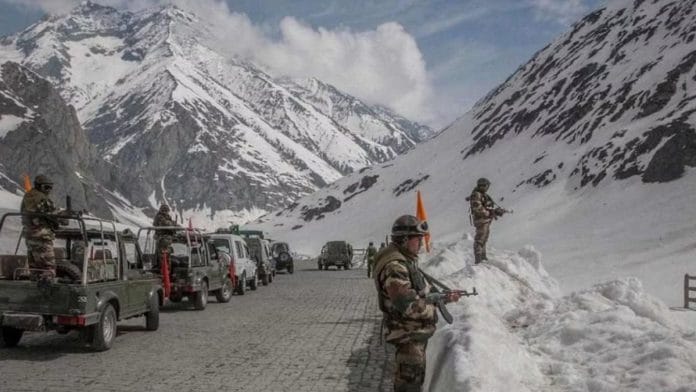Leh: In line with the old adage, ‘an army marches on its stomach’—often attributed to Napoleon—the Indian Army in Ladakh is busy stocking up on food and essential items on a war footing. The efforts are to ensure that the soldiers remain fit for fighting as the brutal winters take over the high-altitude areas, where temperatures can drop even beyond minus 50 degrees Celsius.
Winter season is declared in Ladakh starting 15 November and the Army has to stock up for the next six months as the passes in the region shut down due to heavy snowfall.
This time, Ladakh is expected to witness severe winters as the temperatures have already started dropping.
While there is lesser deployment of troops to the forward areas during the season in coordination with the Chinese, the management of logistics in terms of ration is a mammoth task.
Take, for example, the 3rd Division of the Indian Army, which looks after the Daulat Beg Oldie (DBO), Depsang and Galwan valley. The statistics pertaining to the stockpile for this one division alone are staggering.
Sources told ThePrint that the Army stores less than 2 crore litres of fuel for this division for the winters. In addition, the Army caters for about several hundred metric tonnes of wheat and rice for the soldiers, along with several lakh litres of cooking oil for the next six months. ThePrint has withheld specific numbers due to security considerations.
The wheat procured for the winter season for the Army comes with special preservatives, giving the stock a shelf life of about six months, instead of the usual three.
Sources said that each unit has a dietary preference. For example, those from the southern parts of India would consume more rice, while others from Haryana or Punjab would have higher wheat intake.
Along with this, the Army also caters for every single item needed for preparation of food, like salt, sugar, tea, coffee, turmeric powder, spices and so on.
According to the sources, fresh vegetables and frozen meat are flown to Ladakh on a weekly basis even during winters.
Interestingly, till about 2015, the Army used to send in live animals to forward posts, but since then it has entered into contracts for supply of frozen non-veg items.
The sources said that there are multiple storage houses, including several underground ones, especially for fuel dumps.
As of today, the Army has completed about 60 percent of the winter stock-up. The plan is to complete the rest by November. The military force is hoping for the 4.1-km long Shinku La tunnel, which will provide all-weather connectivity from Manali to Leh via the Nimmu-Padum-Darcha Road, to open up soon, sources said.
They added that as and when the tunnel opens up, the duration for which essentials are stored for winters will reduce to about three months.
This tunnel will cut the distance between Manali and Leh from 355 km to 295 km. It is an alternative to the Manali-Leh-Kargil route.
“The passes otherwise close down. The tunnel would allow round-the-clock transport,” a source said.
Also Read: Kishtwar operation in J&K, which saw 2 soldiers killed, follows a troubling pattern
Deployment since Galwan clash
Besides the 3rd Division, there are at least two other divisions deployed here in addition to independent brigades and independent battalions, and large armoured and artillery columns.
The sources explained that since the Galwan clash in 2020, there has been a huge deployment of troops in the region.
“In terms of logistics, it has grown tenfold since the Galwan clash because of additional deployment. Logistics would mean not just the ration, but also other elements, which are needed to keep the forces ready for any eventuality,” a source said.
Immediately after the clash, India had pumped in about 60,000 additional troops, and around 300 tanks and armoured personnel carriers.
Besides the ration, the Army also transports all kinds of ammunition and munitions, besides spare parts for the systems that have been deployed.
“Logistics is constant, but becomes challenging during winters. Currently, we rely on delivery to forward posts by foot or by aerial dropping. The Army is now testing logistics drones, and as and when they are inducted, it should become easier when it comes to last mile connectivity,” a source told ThePrint.
The first casualty of extreme winters in high altitude areas is hunger, the sources explained. Despite the availability of rations, soldiers prefer eating light because that is what the body allows them, and hence, a lot of dry fruits are also sent to the posts to sustain the soldiers’ energy.
ThePrint was the first to report back in June 2020 that contrary to expectations, the India-China stand-off will be a long drawn one.
ThePrint had also reported in September 2020 that the Line of Actual Control (LAC) will see “LoC-isation” by which troops would be forward deployed round the clock, unlike the earlier practice of thinner deployment and pulling back of positions during winters.
(Edited by Mannat Chugh)
Also Read: With Kashmir in election mode, security bureaucracy unprepared for looming mountain war with Jaish






